
(a)
Interpretation:
Determine the structural formula from the given molecular formula:
20 aromatic
Concept Introduction:
The spatial arrangement of atom within a compound that are joined together is identified with the help of structural formula.
Explanation of Solution
The molecular formula C7 H9 N is 20 on the
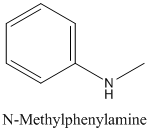
(b)
Interpretation:
Determine the structural formula from the given molecular formula:
30 aromatic amines, C8 H11 N.
Concept Introduction:
The spatial arrangement of atom within a compound that are joined together is identified with the help of structural formula.
Explanation of Solution
Tertiary amines are those compounds in which three hydrogen atoms of ammonia are replaced by alkyl or aryl groups. They are represented as R3 -N or 
The molecular formula, C8 H11 N is 30 on the aromatic amine. Hence, it has six-membered ring. The nitrogen atom is attached to three groups in which one is an aryl group and the other two are methyl groups.
Thus, the structural formula for the molecular formula C8 H11 N is as below:
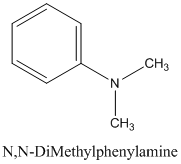
(c)
Interpretation:
Determine the structural formula from the given molecular formula:
10 aliphatic amines, C7 H9 N.
Concept Introduction:
The spatial arrangement of atom within a compound that are joined together is identified with the help of structural formula.
Explanation of Solution
Primary amines are those compounds in which one of the hydrogen atoms of ammonia is replaced by an alkyl or an aryl group. They are represented as 
The molecular formula C7 H9 N is 10 on the aliphatic amine. Hence it has
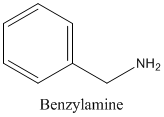
(d)
Interpretation:
Determine the structural formula from the given molecular formula:
A chiral 10 amine, C4 H11 N.
Concept Introduction:
The spatial arrangement of atom within a compound that are joined together is identified with the help of structural formula.
Explanation of Solution
Primary amines are those compounds in which one of the hydrogen atoms of ammonia is replaced by an alkyl or aryl group. They are represented as
The carbon atom attach to four different group is called a chiral atom. When a molecule possesses such atom, then they are not superimposable on their mirror image.
The molecular formula C4 H11 N is 10 on the aliphatic amine, and it is a chiral molecule. Hence, the chiral carbon atom is attached to four different groups, which include -NH2 group, the -CH3 group, the -CH2 group and the -H group. The structural formula of C4 H11 N is as below:
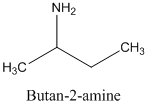
(e)
Interpretation:
Determine the structural formula from the given molecular formula:
A 30 heterocyclic amine, C5 H11 N.
Concept Introduction:
The spatial arrangement of atom within a compound that are joined together is identified with the help of structural formula.
Explanation of Solution
Tertiary amines are those compounds in which three hydrogen atoms of ammonia are replaced by alkyl or aryl groups. They are represented as R3 -N or 
The carbon atom attach to four different group is called a chiral atom. When a molecule possesses such atom, then they are not superimposable on their mirror image.
The molecular formula C5 H11 N is 30 on the heterocyclic amine. This structure has a five membered heterocyclic ring. This ring contains four carbons and one nitrogen atom. The nitrogen atom in the ring is bonded to the methyl group. The structural formula of C4 H11 N is as below:

(f)
Interpretation:
Determine the structural formula from the given molecular formula:
A trisubstituted 10 aromatic amine, C9 H13 N.
Concept Introduction:
The spatial arrangement of atom within a compound that are joined together is identified with the help of structural formula.
Explanation of Solution
Primary amines are those compounds in which one of the hydrogen atoms of ammonia is replaced by an alkyl or aryl group. They are represented as
The molecular formula C9 H13 N is tri substituted 10 on the aromatic amine. Hence, it has six membered rings with three methyl groups. The structural formula of C5 H13 N is as below:
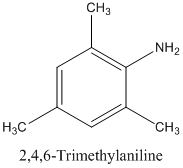
(g)
Interpretation:
Determine the structural formula from the given molecular formula:
A chiral quaternary ammonium salt, C9 H22 NCl.
Concept Introduction:
The spatial arrangement of atom within a compound that are joined together is identified with the help of structural formula.
Explanation of Solution
Quaternary amines are those compounds in which all four of the hydrogen atoms of the ammonium ion are replaced by an alkyl or aryl group. It is an ionic quaternary salt.
When the carbon atom is attached to four different groups, it is called a chiral atom. When a molecule possesses such an atom, then it is not super imposable on its mirror image.
The molecular formula C9 H22 NCl is a quaternary amine and it is a chiral molecule. Hence, the chiral nitrogen atom is attached to four different groups, which include -CH2 CH3 group, the -CH2 CH2 CH3 group, the -CH3 CHCH3 group, and the -CH3 group. Therefore, the quaternary ammonium salt of C9 H22 NCl is as below:
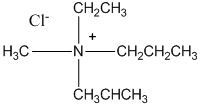
Want to see more full solutions like this?
Chapter 15 Solutions
Introduction to General, Organic and Biochemistry
- > Can the molecule on the right-hand side of this organic reaction be made in good yield from no more than two reactants, in one step, by moderately heating the reactants? esc ? A O O •If your answer is yes, then draw the reactant or reactants in the drawing area below. You can draw the reactants in any arrangement you like. • If your answer is no, check the box under the drawing area instead. olo 18 Ar Explanation Check BB Click and drag to start drawing a structure. 2025 McGraw Hill LLC. All Rights Reserved. Terms of Use | Privacy Center Accessibilityarrow_forwardName the structurearrow_forward> For each pair of substrates below, choose the one that will react faster in a substitution reaction, assuming that: 1. the rate of substitution doesn't depend on nucleophile concentration and 2. the products are a roughly 50/50 mixture of enantiomers. Substrate A Substrate B Faster Rate X CI (Choose one) (Choose one) CI Br Explanation Check Br (Choose one) C 2025 McGraw Hill LLC. All Rights Reserved. Terms of Use | Privacy A F10arrow_forward
- How to draw this mechanism for the foloowing reaction in the foto. thank youarrow_forwardPredict the major products of the following organic reaction: Some important notes: CN A? • Draw the major product, or products, of the reaction in the drawing area below. • If there aren't any products, because no reaction will take place, check the box below the drawing area instead. • Be sure to use wedge and dash bonds when necessary, for example to distinguish between major products that are enantiomers. No reaction. Explanation Check Click and drag to start drawing a structure. 2025 McGraw Hill LLC. All Rights Reserved. Terms of Use Privacy Centerarrow_forwardDraw the major product of the following reaction. Do not draw inorganic byproducts. H3PO4 OHarrow_forward
- Predict the major products of this organic reaction: HBr (1 equiv) Δ ? Some important notes: • Draw the major product, or products, of this reaction in the drawing area below. • You can draw the products in any arrangement you like. • Pay careful attention to the reaction conditions, and only include the major products. • Be sure to use wedge and dash bonds when necessary, for example to distinguish between major products that are enantiomers. • Note that there is only 1 equivalent of HBr reactant, so you need not consider the case of multiple additions. Explanation Check X ©2025 McGraw Hill LLC. All Rights Reserved. Terms of Use | Privacyarrow_forwardFor the structure below, draw the resonance structure that is indicated by the curved arrow(s). Be sure to include formal charges. :ÖH Modify the second structure given to draw the new resonance structure. Include lone pairs and charges in your structure. Use the + and - tools to add/remove charges to an atom, and use the single bond tool to add/remove double bonds.arrow_forwardUsing the table of Reactants and Products provided in the Hints section, provide the major product (with the correct stereochemistry when applicable) for questions below by selecting the letter that corresponds to the exact chemical structures for the possible product. OH conc Hydrochloric acid 40°C Temp A/arrow_forward
- Using arrows to designate the flow of electrons, complete the reaction below and provide a detailed mechanism for the formation of the product OH conc Hydrochloric acid 40°C Temp All chemical structures should be hand drawn on a piece of paper Paragraph BI UAE +varrow_forwarddraw out the following structures plesearrow_forwardDraw everything on a piece of paper outlining the synthesis from acetaldehyde to 2 cyclopentene carboxaldehyde using carbon based reagants with 3 carbons or fewers. Here is the attached image.arrow_forward
 Introduction to General, Organic and BiochemistryChemistryISBN:9781285869759Author:Frederick A. Bettelheim, William H. Brown, Mary K. Campbell, Shawn O. Farrell, Omar TorresPublisher:Cengage Learning
Introduction to General, Organic and BiochemistryChemistryISBN:9781285869759Author:Frederick A. Bettelheim, William H. Brown, Mary K. Campbell, Shawn O. Farrell, Omar TorresPublisher:Cengage Learning Organic ChemistryChemistryISBN:9781305580350Author:William H. Brown, Brent L. Iverson, Eric Anslyn, Christopher S. FootePublisher:Cengage Learning
Organic ChemistryChemistryISBN:9781305580350Author:William H. Brown, Brent L. Iverson, Eric Anslyn, Christopher S. FootePublisher:Cengage Learning Chemistry: The Molecular ScienceChemistryISBN:9781285199047Author:John W. Moore, Conrad L. StanitskiPublisher:Cengage Learning
Chemistry: The Molecular ScienceChemistryISBN:9781285199047Author:John W. Moore, Conrad L. StanitskiPublisher:Cengage Learning General, Organic, and Biological ChemistryChemistryISBN:9781285853918Author:H. Stephen StokerPublisher:Cengage Learning
General, Organic, and Biological ChemistryChemistryISBN:9781285853918Author:H. Stephen StokerPublisher:Cengage Learning Organic And Biological ChemistryChemistryISBN:9781305081079Author:STOKER, H. Stephen (howard Stephen)Publisher:Cengage Learning,
Organic And Biological ChemistryChemistryISBN:9781305081079Author:STOKER, H. Stephen (howard Stephen)Publisher:Cengage Learning, ChemistryChemistryISBN:9781305957404Author:Steven S. Zumdahl, Susan A. Zumdahl, Donald J. DeCostePublisher:Cengage Learning
ChemistryChemistryISBN:9781305957404Author:Steven S. Zumdahl, Susan A. Zumdahl, Donald J. DeCostePublisher:Cengage Learning





